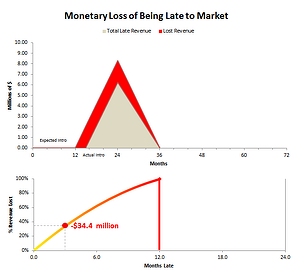How to Calculate Late Time to Market (TTM) Revenue Loss, Part 1
by On Jun 22, 2011
When I speak to semiconductor product managers, directors and VPs, one of the questions I often ask is, “How much does it cost you if your chip is one month late?”
Surprisingly, fewer than half know the number. And even fewer know how to calculate the revenue loss due to being late to market. The purpose of this series of articles is to explain how you can calculate your TTM revenue losses yourself.

In other words, if you had expected $100M in revenue and it cost $30M to make, then you lost more money than the chip cost to make just by being late to market by one quarter!
What is being late to market?
Being late can mean missing an established schedule, or being on time according to your schedule but launching after a competitive offering that arrives on the market sooner. It can also mean being late to market with the features required to sell your product versus other competitive products. In other words, if you are “on time” with a product that has key features stripped from it, then you are not “on time.”
I was first exposed to calculating the cost of being late to market over a decade ago during my MBA new product introduction classes at the MIT Sloan School of Management by pioneering professors in the marketing and technology fields like Glen Urban, Mike Cusumano and John Hauser. They hammered home the value of time, and how the financial cost of “lost time” was mathematically orders of magnitude greater than the other costs that managers find easy to measure, like engineering salaries, tool licenses and sales commissions.
My first civilian employer* was Intel Corporation, and Intel’s “show me the data” culture helped reinforce the need for every manager to know what the cost to the company was if his or her product was late. But this level of financial knowledge has not always been taught at all the companies I have worked with and for.
Late TTM Tutorial Series
In this series of tutorials, I will walk you through the logic of how to calculate revenue loss due to late time to market (TTM), discuss the assumptions and how your answers will change if these assumptions are violated, and ultimately create a spreadsheet tool that you can use to calculate late TTM revenue losses for your own products.
Also, I will be referring often to a paper by Biren Prasad published in the journal, Pricing Strategy & Practice. Specifically, the paper is titled, “Analysis of Pricing Strategies for New Product Introduction.” It was published in 1997 in Volume 5, Number 4 of Pricing Strategy and Practice and is on pages 132-141. You can access this article for a small fee at Emerald Insights.
Until next time!
* I was an active duty Air Force Special Operation Forces officer prior to business school, and am currently an officer in the Air Force Reserves in my “spare” time.
